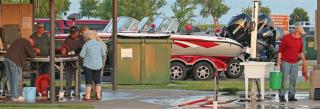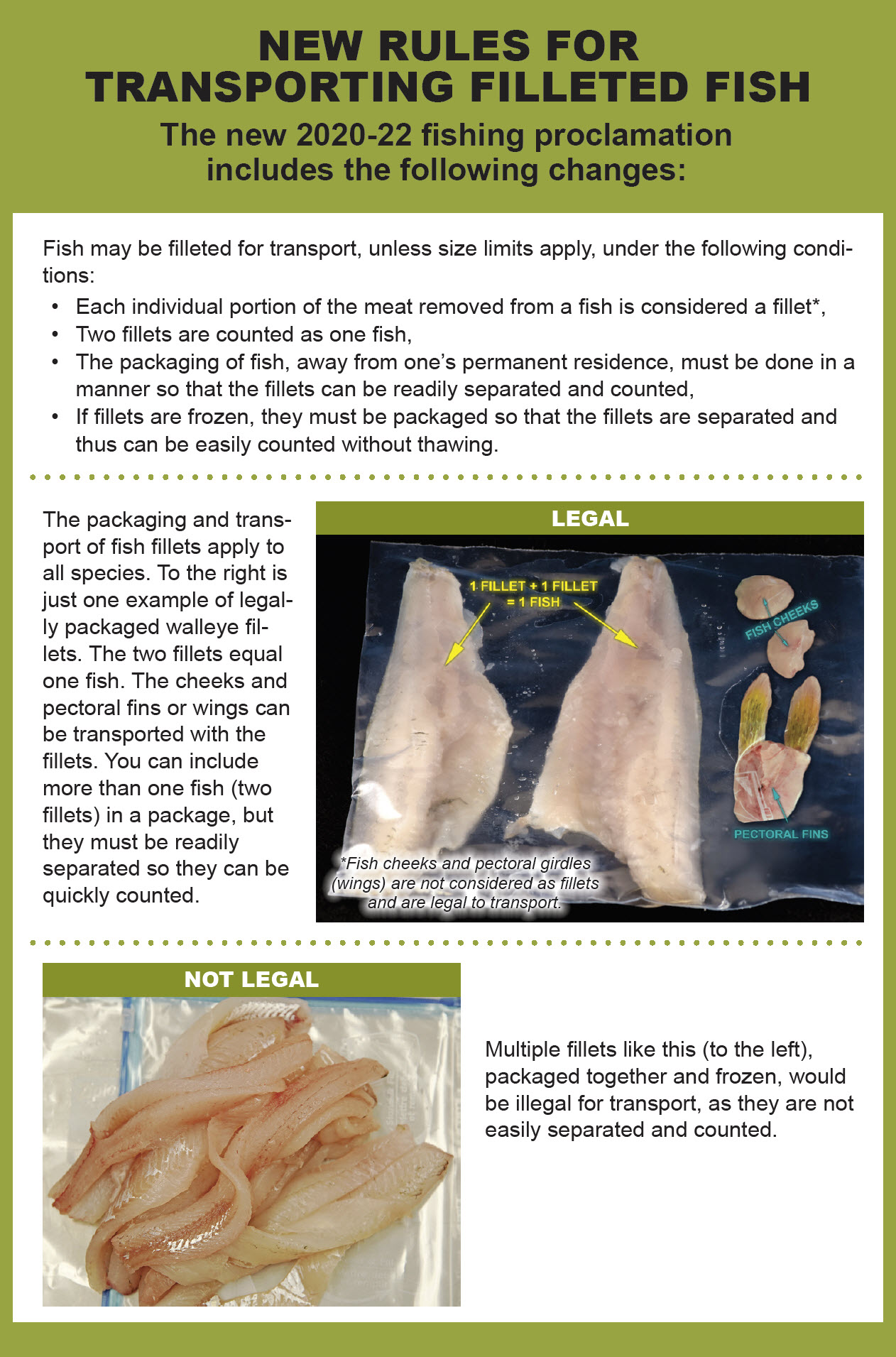

Fish Fillet Transport Rules FAQ
Most anglers clean their fish at their permanent residences (homes) thus this new (effective 2020) transport rule does not apply to most residents who fish in the state. Fish can be cleaned and stored (frozen) in any manner while at one's permanent residence. However, for those (residents and nonresidents) who clean their fish away from their permanent residence and transport their fillets home, please be aware of the following:
- Why the change?
- In the past, anglers were sometimes frustrated when their packages of fish were inspected by wardens. Past fishing proclamation language (“The packaging of fish (including parts thereof) away from one’s residence must be done in such a manner that the number of fish in each package may be easily determined”) caused understanding/interpretation problems with some anglers transporting fish fillets. As such, there were times when both anglers and wardens spent unnecessary time thawing, separating, sorting, counting pieces, etc. to verify how many fish were in the angler’s possession.
- Past language also provided an avenue for concealing over-limits of fish, when they were cut into smaller chunks and thrown into one bag. The new language is intended to reduce past illegal activity where some groups of anglers would take over-limits and cut up fish into (much) smaller pieces, making accurate counts difficult.
- Some anglers who use a fish cleaning station and prefer to cut their fillets into multiple pieces, have expressed concerns about the new fillet transport rule causing anglers to be over their limit despite catching only a legal limit. The reality is –
- Citations for over limits are issued when there is evidence of actual over limits of fish taken/possessed.
- Noncompliance with packaging regulations are a separate issue, and as with any new regulation, while citations may be issued, the focus in the beginning will be on education.
- Did Game and Fish take into consideration the inconveniences this new rule will create?
- Yes, and these inconveniences for the few were weighed against the benefits for all. Again, for some (certainly not most), the way they fillet and/or package their fish will need to be altered slightly. For those who like to fully zipper their fish (primarily walleye), the time it takes and mess that is created to finish/zipper fillets at home is minimal.
- With these new fillet transport rules, is the Game and Fish de-emphasizing the use of the fish cleaning stations (FCS)?
- Not at all. The Game and Fish considers FCS a valuable portion of fishing infrastructure and remains committed to local partners to install, operate and maintain FCS.
- FCS were never designed/intended for all anglers to “finish” their catch and have their fillets immediately freezer ready. Rather, FCS priority use is to serve as a location where anglers can clean fish and dispose of carcasses and guts.
- Some local partners have welcomed the change to speed up the fish cleaning process. In the past, there were occasions when some anglers took an inordinate amount of time cleaning their fish to freezer-ready status, thus backing up lines of anglers waiting to clean their fish.
- Currently, we are systematically upgrading FCS around the state to a new grinder type at the cost of $15,000-$35,000 per station. In addition, the Game and Fish provides grants to local entities totaling around $150,000/year for operations and maintenance of the states FCS.
- Not at all. The Game and Fish considers FCS a valuable portion of fishing infrastructure and remains committed to local partners to install, operate and maintain FCS.
- How do these new rules compare to other states?
- While North Dakota did not establish these to rules to mirror how other states handle this issue, South Dakota, Minnesota and Montana all have similar rules on the books.
- SOUTH DAKOTA Rules
- To legally transport fish you must:
- Not transport fish fillets unless those fillets can be readily counted.
- Package frozen fish individually for transportation or when placed in public storage.
- Remember that individual pieces of fish constitute one fillet; two fillets are the equivalent of one fish.
- To legally transport fish you must:
- MINNESOTA Rules
- You must package and transport fish in such a way that they can be readily unwrapped, separated, identified and counted.
- A fish may not be cut into more than two fillets.
- MONTANA Rules
- Two fillets will be counted as one fish.
- If the catch is frozen prior to transport, each fish or fillet must be packaged so it can be counted.
- SOUTH DAKOTA Rules
- While North Dakota did not establish these to rules to mirror how other states handle this issue, South Dakota, Minnesota and Montana all have similar rules on the books.
- What about cleaning northern pike – one method people use to clean their fish without bones ends up with five pieces of meat from each fish?
- There are a couple of ways to make the transport rules work for pike fillets. First, you can still use the multiple-fillet method to clean your fish. But since each chunk of meat may be counted as a fillet by a game warden, you would have to keep your harvest under the total number of fillets allowed to stay within the rule. This will work for anglers who only keep a handful pike during an outing.
- For anglers who target pike to harvest and want to keep up to the daily limit, there are two ways to stay within the transport rules.
- Some anglers may simply remove the fillets from the pike and keep them intact until they get home to remove the y-bones and further process, rinse and package their fish.
- Other anglers who wish to clean their fish entirely in the field can use a different filleting method to accomplish the task. This alternative method consists of filleting the fish and removing the ribs and y-bones while the skin is still intact, then removing the skin to produce one big, boneless fillet.
Transport Rules Flyer - New for 2020-22
(Click image to view larger)

